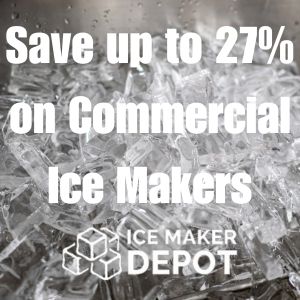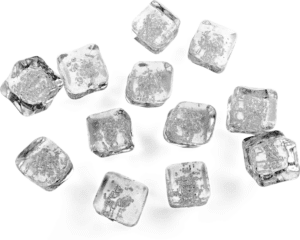
Crushed, Cubed, or Flaked? Choosing the Right Ice Type for Your Business
When you think about commercial ice, you might assume that all ice is the same. But in reality, the type of ice you use can have a significant impact on your business operations, customer satisfaction, and even your bottom line. Whether you’re running a restaurant, bar, hospital, or convenience store, choosing the right type of ice is an important decision.
In this blog, we’ll explore the differences between crushed, cubed, and flaked ice, why the type of ice matters, and how to select the best commercial ice maker to meet your needs. By the end, you’ll be equipped with the knowledge to make an informed decision for your business.
Why Does the Type of Ice Matter?
You might not give much thought to the shape or texture of ice, but your customers and business operations certainly do. The right type of ice can:
- Enhance Customer Experience: Different beverages and food presentations call for specific ice types. For example, cocktails are often served with clear cubes for visual appeal, while smoothies benefit from crushed ice for texture.
- Impact Operational Efficiency: Some ice melts slower, which reduces the need for constant refills. Other types of ice are easier to chew or crush, making them ideal for healthcare or fast-food applications.
- Support Specific Applications: Flaked ice is essential in healthcare and grocery stores for keeping items cool without damaging them, while cubed ice works best for cooling drinks efficiently.
Choosing the right ice type ensures your operations run smoothly while keeping your customers happy.

Understanding the Different Types of Ice
Let’s break down the main types of ice—crushed, cubed, and flaked—and their ideal uses:
1. Cubed Ice
Cubed ice is the most common and versatile type of ice. It’s available in two main forms: full cubes and half cubes.
- Full Cubes: Large, solid cubes that melt slowly. Ideal for cocktails, whiskey, and soft drinks.
- Half Cubes: Smaller and more compact, making them great for blended drinks like smoothies.
Best For
- Restaurants and bars.
- Catering services.
- General-purpose cooling.
2. Crushed Ice
Crushed ice is made by breaking larger ice cubes into small, irregular pieces. It provides a satisfying crunch and blends easily with liquids.
Best For
- Smoothies, slushies, and frozen cocktails.
- Seafood displays.
- Fast-food restaurants.
3. Flaked Ice
Flaked ice consists of soft, snow-like pieces of ice that are easy to mold. It’s commonly used in medical, grocery, and food prep applications.
Best For
- Healthcare (e.g., injuries or hydration).
- Displaying fresh seafood and produce.
- Bakeries for dough preparation.

Commercial Ice Makers for Each Ice Type
Now that you understand the different types of ice, let’s look at the commercial ice makers that produce them.
Cube Ice Makers
Cube ice makers are the most common type of commercial ice machine. They are designed to produce either full or half cubes, with various models offering different production capacities.
Features to Look For
- High production rate for busy establishments.
- Storage bins to hold large quantities of ice.
- Energy-efficient models to reduce utility costs.
Popular Brands
- Scotsman Prodigy Plus Cube Ice Maker: Known for its reliability and energy efficiency.
- Manitowoc Neo Series: Compact and perfect for small restaurants or bars.
Crushed Ice Makers
Crushed ice machines either produce crushed ice directly or come with a built-in crusher to break down cubes.
Features to Look For
- Adjustable crushing settings for different ice textures.
- Durable blades or mechanisms for consistent performance.
Popular Brands
- Hoshizaki Ice Crushers: Efficient and built for high-volume crushing.
- Vollrath Ice Crushers: Compact and user-friendly for smaller operations.

Flaked Ice Makers
Flaked ice machines are highly specialized and designed to produce soft, moldable flakes. They are ideal for businesses needing ice for displays or medical applications.
Features to Look For
- High production output for continuous use.
- Stainless steel components for durability and hygiene.
Popular Brands
- Ice-O-Matic GEM Series: Known for consistent flake production.
- Scotsman Flake Ice Makers: Energy-efficient and easy to maintain.
Does Ice Type Affect Production Time?
The type of ice you choose can also influence how long it takes to produce. Here’s a quick breakdown:
- Cubed Ice: Generally, cube ice is quicker to produce than other types, especially with advanced machines that freeze water efficiently. However, full cubes take slightly longer than half cubes due to their size.
- Crushed Ice: If the machine produces crushed ice directly, it may take longer than cubed ice because of the additional processing step. For machines that crush existing cubes, production is faster but depends on the crusher’s efficiency.
- Flaked Ice: Flaked ice typically takes the longest to produce because it involves freezing water and then shaving it into thin flakes.
Cost Considerations for Commercial Ice Makers
Investing in a commercial ice maker involves upfront costs and ongoing maintenance. Here’s what to expect:
| Ice Type | Average Machine Cost | Monthly Operating Costs | Ideal For |
|---|---|---|---|
| Cubed Ice | $2,000–$5,000 | $50–$150 | Restaurants, bars, general-purpose use |
| Crushed Ice | $2,500–$6,000 | $75–$200 | Fast-food chains, blended drinks |
| Flaked Ice | $3,000–$8,000 | $100–$300 | Medical, grocery, seafood displays |
In addition to the purchase price, consider energy efficiency and water usage, as these factors affect operating costs. Look for ENERGY STAR-rated models to save on utilities.
How to Choose the Right Ice Maker for Your Business
Choosing the right ice maker depends on your business’s specific needs.
Understand Your Daily Ice Requirements
Estimate how much ice you’ll need on a typical day. Restaurants and bars generally require more ice than retail stores or bakeries. Most commercial machines specify their production capacity in pounds per day, so look for a model that exceeds your daily demand.

Consider the Ice Type
Match the ice type to your business operations:
- Full or Half Cubes: Best for beverages and general cooling.
- Crushed Ice: Ideal for blended drinks and food displays.
- Flaked Ice: Essential for specialty applications like medical use or seafood displays.
Evaluate Space and Storage Needs
Measure the available space for your ice maker and consider whether you’ll need a separate storage bin. Some machines come with built-in storage, while others require an external bin.
Maintenance and Cleaning
Choose a machine that’s easy to maintain and clean. Regular cleaning is essential to prevent ice contamination and maintain performance. Look for models with automated cleaning cycles or antimicrobial components.
Choosing the right type of ice and the corresponding commercial ice maker is critical for optimizing your business operations. Whether you need cubed ice for cocktails, crushed ice for smoothies, or flaked ice for displays, understanding your needs will help you make the best decision.
Investing in a high-quality commercial ice maker ensures consistent ice production, improves customer satisfaction, and keeps your business running smoothly. Start by evaluating your daily requirements, considering space limitations, and researching reputable brands to find the perfect machine for your needs.

